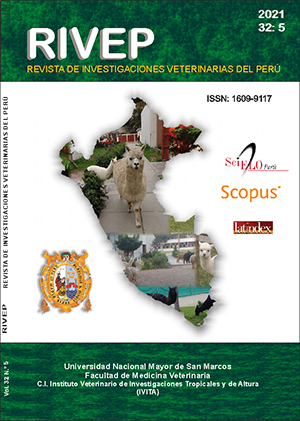Beak trimming and stocking densities for laying and performance traits and behavioral patterns in Japanese quails
DOI:
https://doi.org/10.15381/rivep.v32i5.19248Keywords:
aggressiveness, coturniculture, egg laying performance, ethology, stocking densityAbstract
The present experiment was conducted to evaluate the productive performance, egg quality and behavioral patterns of Japanese quails (Coturnix coturnix japonica) with and without beak trimming submitted to two stocking densities. The study was conducted for 84 days. In total, 196 Japanese quails were randomly allocated to a 2 x 2 factorial scheme: submitted or not to beak trimming procedure and low (237.5 cm²/bird) and high stocking density (316.7 cm/bird) and its interaction. Eight replicates per treatment were used, totaling 32 experimental units. Collected data were submitted to analysis of variance and, means of parametric data were compared by Tukey test (p<0.05); otherwise non-parametric analysis of variance were applied for non-parametric data of quail behavior. Lower feed intake was observed in the high stocking density group (p<0.05) but did not affect other parameters (p>0.05). There was no interaction (p>0.05) between beak trimming and stocking density over performance and egg quality. Quails without beak trimming housed in higher density showed more aggressiveness and stress. Egg quality as well as performance parameters of Japanese quails are not affected by applying 316.7 cm2/bird density.
Downloads
Downloads
Published
Issue
Section
License
Copyright (c) 2021 Daniela Paz Aguiar, Jean Kaique Valentim, Heder José D’Ávila Lima, Tatiana Marques Bittencourt, Lorena Zullian Andreoti, Isabelli Dias Brito Pereira, Jonatan Mikhail Del Solar Velarde, Joyce Zanella

This work is licensed under a Creative Commons Attribution 4.0 International License.
AUTHORS RETAIN THEIR RIGHTS:
a. Authors retain their trade mark rights and patent, and also on any process or procedure described in the article.
b. Authors retain their right to share, copy, distribute, perform and publicly communicate their article (eg, to place their article in an institutional repository or publish it in a book), with an acknowledgment of its initial publication in the Revista de Investigaciones Veterinarias del Perú (RIVEP).
c. Authors retain theirs right to make a subsequent publication of their work, to use the article or any part thereof (eg a compilation of his papers, lecture notes, thesis, or a book), always indicating the source of publication (the originator of the work, journal, volume, number and date).



